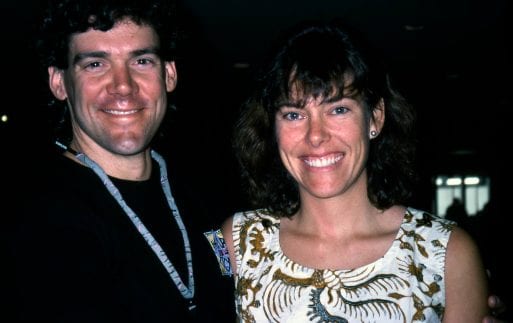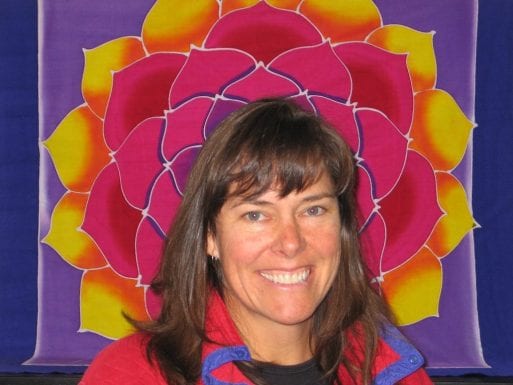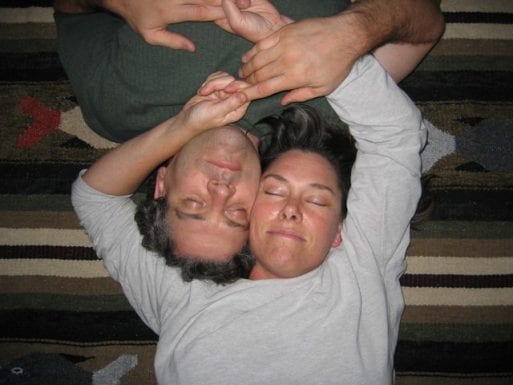 This is the story of Richard and his wife Cari as told to Ellary Allis. Our “Opening Our Hearts” stories are based on people’s real-life experiences. By sharing these experiences publicly, we hope to help our readers feel less alone in their grief and, ultimately, to aid them in their healing process. In this post, Richard talks about Cari’s life and work, her long illness and her eventual death from a brain tumor.
This is the story of Richard and his wife Cari as told to Ellary Allis. Our “Opening Our Hearts” stories are based on people’s real-life experiences. By sharing these experiences publicly, we hope to help our readers feel less alone in their grief and, ultimately, to aid them in their healing process. In this post, Richard talks about Cari’s life and work, her long illness and her eventual death from a brain tumor.
My wife Cari, who passed away in 2017, was my introduction into the positive death movement. In 2005, Cari’s father was diagnosed with a rare form of cancer, and when he became ill, Cari and her brother became his primary caregiver. Through her father’s illness, she saw how hospice worked with her family.
You know how they say that your bliss finds you? Cari was so inspired by that experience that she decided that her work in this world was to take care of people at the end of life. We were both massage therapists and decided to begin caring for hospice patients at our local hospital in Lake Tahoe. We would also support the families of patients in hospice.
Cari was made for the work she did. She was able to be calm and cool and loving and rational in a time when a lot of people aren’t because they’re in a heightened state of emotional arousal.
Eventually, Cari became an end-of-life doula and then went on to become a licensed funeral director in the state of California. She also became a board member of the National Home Funeral Alliance and an advisor for the Green Burial Council and the Funeral Consumers Alliance of Southern California. Her mission in life was to help create a shift in the way our culture views death. She helped people see all the different options that they could have, not only in the dying process but then in the after-death care. Whether they wanted a green burial or a deep-sea burial or something else, she let them know that they had options. Not only was I supporting her in her work, but I fell in love with the positive death movement as well.

Cari became involved in all of this end-of-life work before she had any known health issues. But the same year her father died, she began developing terrible headaches. Then in 2012, she learned through an MRI that she had an extraordinarily large brain tumor. It was benign, but it was so large that it was displacing her brain — squishing everything from one side to the other. The doctors at UCSF and Johns Hopkins told her that she could have a 14-hour brain surgery to remove the tumor, and if she didn’t have the surgery she would most likely die within three to six months.
Cari decided that she didn’t want to have the surgery. She said she was okay with letting the rest of her life play out. We never had children, and we both believe that our souls are eternal. Cari decided for those reasons that she was okay with dying from the brain tumor if that was her fate. Because that was her wish, I was in full support. As you can imagine, we had many conversations about infinite numbers of aspects of that decision. She ended up living another two and a half years after her diagnosis.
I was Cari’s primary caregiver during her illness. Ram Dass says that we’re all just walking each other home, and I helped walk Cari home. We also enlisted the help of the end-of-life doulas that were available through our local hospice. The end-of-life doulas who cared for Cari were actually her classmates and her colleagues.
Cari and I were married for 27 years, and for 25 of those years, we lived in Truckee, Lake Tahoe. But when Cari was diagnosed, she said, “I really want to die by the ocean.” So we moved to Morro Bay. Her ideal death was to die at home, in her bed, surrounded by loved ones: myself, her mom, her brother, our cat Oscar — so that’s what happened. She got her wish. She died in a bed in our living room, looking out over the Pacific Ocean.
After she died, Cari’s mom and one of the end-of-life doulas washed her hair and washed her body with soap and water and essential oils. Then the other end-of-life doulas and I anointed her body with essential oils and dressed her. We kept her body in the bed in the living room at home for two days, using dry ice. Her body was not stable enough to stay in that state beyond those two days, so even though she wanted to be buried at sea, she was cremated. After we received her cremains, which I call her stardust, we held a shrouding ceremony at our local hospice.
 Since we were unable to grant Cari her wish for a full-body shrouded deep-sea burial, we invented our own shrouding ritual. We took Cari’s clothes and invited our friends and loved ones over and everyone stuffed her clothes with aromatic and medicinal herbs. Then we sprinkled her stardust over this effigy we’d made of her, wrapping the effigy in a shroud the way we would have wrapped her body. We held the ceremony at our local hospice, the hospice of San Luis Obispo, in the same classroom where she took her end-of-life doula training. The next day we took her shrouded effigy along with sandbags and went out on a sailboat. We sailed out of Santa Barbara Harbor toward the Channel Islands and gave her the shrouded deep-sea burial that she wanted.
Since we were unable to grant Cari her wish for a full-body shrouded deep-sea burial, we invented our own shrouding ritual. We took Cari’s clothes and invited our friends and loved ones over and everyone stuffed her clothes with aromatic and medicinal herbs. Then we sprinkled her stardust over this effigy we’d made of her, wrapping the effigy in a shroud the way we would have wrapped her body. We held the ceremony at our local hospice, the hospice of San Luis Obispo, in the same classroom where she took her end-of-life doula training. The next day we took her shrouded effigy along with sandbags and went out on a sailboat. We sailed out of Santa Barbara Harbor toward the Channel Islands and gave her the shrouded deep-sea burial that she wanted.
Cari and I were married for 27 years and together for 28. It was clear to me after she died that grief was actually an expression of love, and they’re directly relative. If you have a deep love for something there’s going to be deep grief as well. The amount and depth of grief I have for her death and her absence is huge because our love was huge.
We live in a largely grief avoidant culture that wants to put a time limit on our pain. It became clear to me that my grief was something I wanted to lean into and deepen into. Death and grief and the whole range of human emotions can be incredible and beautiful and actually create a deeper embracing of life than if we avoid it or deny it. That was Cari’s legacy, and it’s what I advocate for still.

 Carrying on Cari’s Legacy After her Death
Carrying on Cari’s Legacy After her Death


 How Dare You Die Now!
How Dare You Die Now!
 Debating Medical Aid in Dying
Debating Medical Aid in Dying















